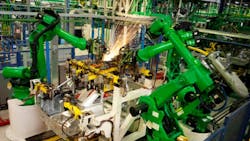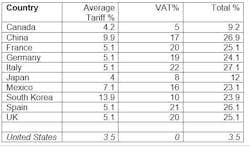Free market economists have been very successful at convincing the public that free trade is good and protectionism is bad. The truth is that multinational corporations and their shareholders have done very well under the banner of free trade, but manufacturing, workers, communities and the middle class have not.
Free-market ideologies allow a hybrid capitalistic system like that in China to operate under its own rules--to cheat, manipulate their currencies, subsidize industries and steal technologies—while the U.S. plays by the market rules. According to a 2017 report from the federal Commission on the Theft of American Intellectual Property, the annual loss to the U.S. economy from Chinese IP theft was between $225 billion and $600 billion.
The U.S. not only doesn’t have a trade policy; it doesn’t have a plan. China, on the other hand, has a well-defined 10-year plan on how to become No. 1. Called Made in China 2025, it uses a combination of government subsidies, state-owned enterprises and the pursuit of intellectual property to catch up with and ultimately overtake other countries in 10 key sectors, from IT and telecommunications to advanced robotics and artificial intelligence.
So far, cheating has paid off handsomely for China. According to the Organization for Economic Cooperation and Development (OECD), China’s exports “have exploded in nearly every big money manufacturing sector,” including railroad equipment (a 600% increase from 2001 to 2017), machinery and equipment(900%), cars(1200%), marine vehicles (1100%), and airplanes (1200%).
Meanwhile, in the U.S., working-class jobs in areas like machinery and equipment manufacturing, fabricated metals, automotive, paper and pulp, and textiles have all seen wage growth fall below inflation over the last 20 years, according to the OECD.
America is slowly losing the trade battle. Free trade, as it exists today, will guarantee the long-term decline of U.S. manufacturing as multinational corporations continue to move production to low-cost countries, and China is allowed to play by its own rules.
If we are going to have any chance of growing our manufacturing industries, we need to replace the notion of free trade with the concept of managed trade. To do this, we need an industrial policy that commits to growing the U.S. manufacturing sector as a percentage of GDP. The manufacturing sector has been stagnant at around 12% of GDP for many years. (In 2018 it was 11.6% of GDP). If we are serious about real manufacturing growth, we should pick a target for growth—like 14.5% which was manufacturing’s percentage of GDP in 2000-- and publicize it.
The industrial policy should also include a specific goal to reduce the trade deficit. Not a general statement saying trade deficits are bad. I mean a specific goal with the timetable to reduce the trade deficit. To achieve this goal, we will have to solve many major problems that restrict manufacturing growth, such as:
Currency manipulation. If the U.S. is going to begin reducing the trade deficit and growing exports, it must penalize countries for artificially increasing the value of the dollar so their exports to the U.S. are cheaper and our exports are more expensive.
According to the Economic Policy Institute, the President has the power to shape policy that would penalize currency manipulation.
“Together, these policies could lead to exchange rate movements that would create 2.3 million to 5.8 million jobs over the next three years by ending currency manipulation by a group of about 20 countries, with China as the linchpin,” the EPI stated.
There is precedent. In 1982, President Reagan held a private meeting at the Plaza Hotel in New York to tell Japan, Germany, and three other trading partners they had to quit manipulating their currencies that kept the U.S. dollar high. It worked, and the trade deficit began to subside.
Reciprocity and tariffs. The Trump administration is beginning to get China's attention by imposing tariffs on imported goods. We need to go a step further and analyze all of the tariffs and value-added taxes placed on our exports, country by country.
The following chart shows the tariffs and VATs of 10 of our largest trading partners.
The U.S. allowed this to happen under free market capitalism, and we must do something about it. There is a new bill in Congress called the Reciprocal Trade Act that will give the President the power to match these tariffs and Value Added Taxes.
Infrastructure. Despite the political and economic backsliding, I think the investment in rebuilding our infrastructure is perhaps the best economic investment we can make. This is an opportunity to modernize the country for all citizens, businesses, and economic sectors and would provide growth for both the manufacturing and the construction industries. The economic returns are far greater than the invested costs. We cannot afford to not invest in our infrastructure if we want to be a competitive economy in the twenty first century.
Apprenticeship programs. Recently, the Manufacturing Institute and Deloitte released another skills gap study that says that the skills gap is expected to grow from 448,000 unfilled jobs today to as many as 2.4 million in 2025. The essence of this problem is that the workers needed do not exist and require lengthy training that matches the automation needs of today's manufacturers.
Corporations need to bite the bullet and invest in long-term apprentice training to create the multi-skilled workforce needed if we really want American manufacturing to grow.
Stopping the loss of technologies. America’s only chance to keep its position as the No.1 economy is through innovation and pushing back against countries and foreign companies that steal our technologies. We are not just losing the technologies; we are losing whole industries. This scenario begs the obvious question: How many technologies and industries can we lose before we also lose our ability to compete, using innovation as our primary strategy? We must face the fact that foreign countries are reaping the rewards from technologies pioneered in the U.S.
American multinational companies are complicit in losing our technologies. They want access to the huge Chinese markets but have to cede their intellectual property to get it. They give away their technology when they sign joint venture and tech transfer agreements, or simply expose technology secrets by manufacturing the products in a foreign country.
Strengthening our innovation strategy. America’s only chance to keep its position as the No. 1 economy is through innovation based on the continuous development of new products and technologies. Using the WTO to enforce fair-trade laws and treaty obligations has simply not worked. Now that President Trump has challenged China with tariffs, we finally have China’s attention and some leverage. It is time to use this leverage to establish new rules and enforcements that come with severe fines, just like tariffs.
We must save and grow the American Manufacturing sector because:
1. First and foremost, it is obvious that the countries with the fastest overall growth are countries like China with a growing manufacturing sector.
2. Global trade is based on goods, not services. If the U.S. is going to have any chance of reducing its trade deficit and growing exports, it will have to grow its manufacturing sector.
3. The development of new technologies and innovations comes primarily from manufacturing, not services.
4. Manufacturing has the best job multiplier of any other sector in the economy, and provides the most job opportunities for people who don't have a college education.
5. Manufacturing creates the technologies and products for the military and national security.
6. Historically, every country that has shifted its economy from manufacturing to finance has lost its position as the leading economy in the world.
In an article by the Coalition for a Prosperous America, Senator Marco Rubio told Breitbart News that “China's intense international push for global dominance is the biggest threat that America has ever faced, even more substantial than the one that the Soviet Union posed in the 20th century.”
If the growth of the manufacturing sector is considered critical to the future of our economy and staying ahead of China, then we need to develop an industrial policy and plan that spells out the details of how we can achieve this growth. Crucial to this industrial policy is the adoption of a new policy of managed trade rather than free market trade.
Wall Street and the multinational corporations are not going to favor a policy of managed trade, because they have been the biggest recipients of the free market policies and would like to maintain the status quo. Free-market Republicans have always been against an industrial policy or government intervention—but to really grow, American manufacturing needs an industrial policy that defines strategies for growth.
Michael Collins is the author of Saving American Manufacturing.

